Modeling Flow Pattern and Evolution of Meandering Channels with a Nonlinear Model
Abstract
:1. Introduction
2. Mathematical Model
2.1. Hydrodynamic Submodel
2.2. Bank Erosion Submodel
3. Solution Algorithm
4. Model Test
4.1. Case 1: Da Silva’s Flume Experiments
4.2. Case 2: Friedkin’s Laboratory Experiment
5. Discussion
5.1. Sensitivity of the Nonlinear Terms on Channel Geometry
5.2. Impact of the Nonlinear Terms on Flow Pattern and Meander Evolution
5.3. Limitations of the Present Model
- (1)
- A Kinoshita-type planform with fixed flatness and skewness is imposed to approximate the channel centerline in order to suppress the numerical instability. This assumption might be the cause for the deviation between the model results and the measured data in Friedkin’s [30] experiment. The assumption should be replaced in order to allow the channel to develop into freely meandering planforms in the future development.
- (2)
- The present model does not include a cut-off and local re-straightening module, and thus can handle the simulation of meander evolution only up to the incipient neck cut-off. The cut-off will inevitably occur when the channel sinuosity grows until the upstream and downstream limbs are jointed. The modules to describe the occurrences of cut-off events and local re-straightening processes should be incorporated in the model for simulating the long-term river planform dynamics.
- (3)
- The Levy-type equation adopted in the bed erosion model is an empirical sediment transport equation based on certain datasets, and only accounts for bed-load transport in a certain particle size range. Extension and generalization of the description of sediment transport, including both the bed-load and suspended-load transport, should be considered in the future development for a wider range of applications of meander evolution.
- (4)
- The width adjustment process is not simulated in the present study. Parker et al. [19] proposed a theoretical framework for meander migration by using separate relations for modeling the migrations of the eroding and depositing banks, which has been successfully applied in [27] in simulating the coevolution of the width and sinuosity of the meandering channels. Due to the importance of the aspect ratio (width-to-depth ratio) in determining the nonlinear dynamics of the meander channel, the effect of width adjustment should be considered in the future development.
6. Conclusions
- The proposed nonlinear model is applicable in simulating the flow field and the evolution process of meandering channels with various sinuosities. It is found that the nonlinear effect is trivial in mildly curved channels, but is nonnegligible in strongly curved channels, which is in agreement with the conclusion in Xu et al. [20]. The αs/R profile computed by both the linear and nonlinear models agree well with the experimental data in da Silva’s 30° experiment [29], whereas the nonlinear αs/R profile match better with the experimental data than the linear model in da Silva’s 110° experiment, confirming the findings of Blanckaert and de Vriend [5] and Ottevanger et al. [3] that the nonlinear model outperforms the linear model in strongly curved channels.
- In the simulation of Friedkin’s experiment [30], the bend growth rates computed by both models generally agree with the measured data, but the computed channel centerlines locally deviate from the measured centerline possibly due to the imposed Kinoshita-type planform and the prescribed bed scour factor. The channel centerline simulated by the nonlinear model migrates slower than that by the linear model in the downstream of the meander apex due to the nonlinear hydrodynamic interactions. However, the difference between the nonlinear and the linear results are not obvious, possibly due to the high width-to-depth ratio in this case.
- The sensitivity analysis indicates that the magnitude of the additional terms in the nonlinear model increases with increasing maximum direction angle (sinuosity) and decreasing channel length. This is also consistent with the findings of Xu et al. [20] that the influence of nonlinearity generally increases with sinuosity and decreases with channel scale.
- The additional processes considered in the nonlinear model tend to cause the computed discharge bisector line to be closer to the original channel centerline, and the channel evolution process to slow down. This is in consistent with the findings of Abad et al. [17], Bai and Wang [38], but seemingly contradicts with Eke et al. [27], who reported the migration rate decreased with increasing wavelength possibly because the width adjustment was also simulated in their study. The difference between the nonlinear and linear channel centerlines after migration is in phase with the difference of the nonlinear and linear RHS terms, indicating that the simulated channel migration process is strongly affected by the additional processes accounted for in the nonlinear model. Nonetheless, the difference between the nonlinear and linear discharge bisector lines shows a different spatial distribution, indicating that the influence of the nonlinear processes on the simulated flow pattern is more complex possibly due to the strong three-dimensional characteristics of meander flow.
Acknowledgments
Author Contributions
Conflicts of Interest
Nomenclature
| αs | normalized transverse distribution of streamwise velocity |
| Us | depth-averaged longitudinal flow velocity |
| Un | depth-averaged transverse flow velocity |
| U | width-averaged flow velocity |
| R | radius of curvature of channel centerline |
| Rs | radius of curvature of the streamline |
| s | longitudinal coordinates |
| n | transverse coordinates |
| zs | water surface elevation |
| zb | bed elevation |
| τb | bed shear stress |
| ρ | fluid density |
| ρs | sediment density |
| vs* | residual longitudinal velocity components |
| vn* | residual transverse velocity components |
| H | width-averaged flow depth |
| Cf | Chezy’s friction coefficient |
| Fr | Froude number |
| B | channel width |
| b | half width of the channel |
| ψ | flow resistance amplification coefficient due to bend effects |
| χ | shape coefficient related to the transverse velocity profile |
| A | scour factor related to the transverse bed slope |
| <fsfn> | shape coefficient defining the average transverse transport of the streamwise quantities |
| gsn | shape coefficient characterizing the transverse distribution of <fsfn> |
| β | bend parameter |
| ψsec | additional friction due to secondary flow |
| ψαs | the deformation of velocity profiles |
| ψtur | increased turbulence production rate |
| κ | Karman constant |
| h | local flow depth |
| Q | flow discharge |
| nDB | transverse coordinate of the discharge bisector line |
| P | sediment bed porosity |
| kf | coefficient characterizing the sediment transport intensity |
| D | representative size of sediment bed |
| Cs | the ratio of transverse to longitudinal sediment transport |
| qs | sediment transport rates in the longitudinal direction |
| qn | sediment transport rates in the transverse direction |
| ατ | deviation of bed shear stress to depth-averaged flow velocity due to secondary currents |
| gτ | width distribution function |
| ψτ | nonlinear correction to the deviation |
| G | gravitational pull |
| τ* | dimensionless bed shear stress |
| g | gravitational acceleration |
| ζ | under-relaxation factor |
| Uc | critical flow velocity for sediment entrainment |
| L | meander wavelength |
| ω | bank migration rate |
| S | streamwise channel slope |
| θ | direction angle of channel centerline |
References
- Termini, D. Experimental Observations of Flow and Bed Processes in Large-Amplitude Meandering Flume. J. Hydraul. Eng. 2009, 135, 575–587. [Google Scholar] [CrossRef]
- Blanckaert, K. Topographic steering, flow recirculation, velocity redistribution, and bed topography in sharp meander bends. Water Resour. Res. 2010, 46, 2095–2170. [Google Scholar]
- Ottevanger, W.; Blanckaert, K.; Uijttewaal, W.S.J. Processes governing the flow redistribution in sharp river bends. Geomorphology 2012, 163–164, 45–55. [Google Scholar] [CrossRef]
- Ikeda, S.; Parker, G.; Sawai, K. Bend Theory of River Meanders. Part 1. Linear Development. J. Fluid Mech. 1981, 112, 363–377. [Google Scholar] [CrossRef]
- Blanckaert, K.; de Vriend, H.J. Meander dynamics: A nonlinear model without curvature restrictions for flow in open-channel bends. J. Geophys. Res. 2010, 115, 79–93. [Google Scholar] [CrossRef]
- Chen, D.; Duan, J.D. Simulating sine-generated meandering channel evolution with an analytical model. J. Hydraul. Res. 2006, 44, 363–373. [Google Scholar] [CrossRef]
- Blondeaux, P.; Seminara, G. A Unified Bar Bend Theory of River Meanders. J. Fluid Mech. 1985, 157, 449–470. [Google Scholar] [CrossRef]
- Johannesson, H.; Parker, G. Linear Theory of River Meanders. In River Meandering; Ikeda, S., Parker, G., Eds.; American Geophysical Union: Washington, DC, USA, 1989; pp. 181–213. [Google Scholar]
- Zolezzi, G.; Seminara, G. Downstream and upstream influence in river meandering. Part 1. General theory and application to overdeepening. J. Fluid Mech. 2001, 438, 183–211. [Google Scholar] [CrossRef]
- Chen, D.; Duan, J.G. Modeling width adjustment in meandering channels. J. Hydrol. 2006, 321, 59–76. [Google Scholar] [CrossRef]
- Blanckaert, K.; de Vriend, H.J. Nonlinear modeling of mean flow redistribution in curved open channels. Water Resour. Res. 2003, 39, 1375–1388. [Google Scholar] [CrossRef]
- Ottevanger, W.; Blanckaert, K.; Uijttewaal, W.S.J.; de Vriend, H.J. Meander dynamics: A reduced-order nonlinear model without curvature restrictions for flow and bed morphology. J. Geophys. Res. 2013, 118, 1118–1131. [Google Scholar] [CrossRef]
- Chen, D.; Tang, C.L. Evaluating secondary flows in the evolution of sine-generated meanders. Geomorphology 2012, 163–164, 37–44. [Google Scholar] [CrossRef]
- Odgaard, A.J. River-Meander Model. I: Development. J. Hydraul. Eng. 1989, 115, 1433–1450. [Google Scholar] [CrossRef]
- Imran, J.; Parker, G.; Pirmez, C. A nonlinear model of flow in meandering submarine and subaerial channels. J. Fluid Mech. 1999, 400, 295–331. [Google Scholar] [CrossRef]
- Camporeale, C.; Perona, P.; Porporato, A.; Ridolfi, L. Hierarchy of models for meandering rivers and related morphodynmic processes. Rev. Geophys. 2007, 45. [Google Scholar] [CrossRef]
- Abad, J.D.; Buscaglia, G.C.; Garcia, M.H. 2D stream hydrodynamic, sediment transport and bed morphology model for engineering applications. Hydrol. Process. 2008, 22, 1443–1459. [Google Scholar] [CrossRef]
- Bolla, P.M.; Nobile, G.; Seminara, G. A nonlinear model for river meandering. Water Resour. Res. 2009, 45, 546–550. [Google Scholar]
- Parker, G.; Shimizu, Y.; Wilkerson, G.V.; Eke, E.C.; Abad, J.D.; Lauer, J.W.; Paola, C.; Dietrich, W.E.; Voller, V.R. A new framework for modeling the migration of meandering rivers. Earth Surf. Process. Landf. 2011, 36, 70–86. [Google Scholar] [CrossRef]
- Xu, D.; Bai, Y.C.; Ma, J.M.; Tan, Y. Numerical investigation of long-term planform dynamics and stability of river meandering on fluvial floodplains. Geomorphology 2011, 132, 195–207. [Google Scholar] [CrossRef]
- Thorne, C.R.; Osman, M.A. The influence of bank stability on regime geometry of natural channels. Int. Conf. River Regime 1988, 18, 135–147. [Google Scholar]
- Darby, S.E.; Thorne, C.R. Numerical simulation of widening and bed deformation of straight sand-bed rivers. I: Model development. J. Hydraul. Eng. 1996, 122, 184–193. [Google Scholar] [CrossRef]
- Darby, S.E.; Thorne, C.R.; Simon, A. Numerical simulation of widening and bed deformation of straight sand-bed rivers. II: Model evaluation. J. Hydraul. Eng. 1996, 122, 194–202. [Google Scholar] [CrossRef]
- Tsujimoto, T. Fluvial processes in streams with vegetation. J. Hydraul. Res. 1999, 37, 789–803. [Google Scholar] [CrossRef]
- Nagata, N.; Hosoda, T.; Muramoto, Y. Numerical analysis of river channel processes with bank erosion. J. Hydraul. Eng. 2000, 126, 243–252. [Google Scholar] [CrossRef]
- Eke, E.; Parker, G.; Shimizu, Y. Numerical modeling of erosional and depositional bank processes in migrating river bends with self-formed width: Morphodynamics of bar push and bank pull. J. Geophys. Res. 2014, 119, 1455–1483. [Google Scholar] [CrossRef]
- Eke, E.C.; Czapiga, M.J.; Viparelli, E.; Shimizu, Y.; Imran, J.; Sun, T.; Parker, G. Coevolution of width and sinuosity in meandering rivers. J. Fluid Mech. 2014, 760, 127–174. [Google Scholar] [CrossRef]
- Duan, J.D. Simulation of Alluvial Channel Migration Processes with a Two-Dimensional Numerical Model. Ph.D. Thesis, The University of Mississippi, University, MS, USA, 1998. [Google Scholar]
- Da Silva, A. Turbulent Flow in Sine-Generated Meandering Channel. Ph.D. Thesis, Queen’s University, Kingston, ON, Canada, 1995. [Google Scholar]
- Friedkin, J. A Laboratory Study of the Meandering of Alluvial Rivers; Technical Reports; U.S. Waterways Experiment Station: Vicksburg, MS, USA, 1945. [Google Scholar]
- Blanckaert, K. Saturation of curvature-induced secondary flow, energy losses, and turbulence in sharp open-channel bends: Laboratory experiments, analysis, and modeling. J. Geophys. Res. 2009, 114. [Google Scholar] [CrossRef]
- De Vriend, H.J. A Mathematical Model of Steady Flow in Curved Shallow Channels. J. Hydraul. Res. 1977, 15, 37–54. [Google Scholar] [CrossRef]
- Chien, N.; Wan, Z. Mechanics of Sediment Transport; ASCE Press: Reston, VA, USA, 1999. [Google Scholar]
- Sekine, M.; Parker, G. Bed-Load Transport on Transverse Slope. I. J. Hydraul. Eng. 1992, 118, 513–535. [Google Scholar] [CrossRef]
- Abad, J.D.; Garcia, M.H. Experiments in a high-amplitude Kinoshita meandering channel: 1. Implications of bend orientation on mean and turbulent flow structure. Water Resour. Res. 2009, 45, 325–336. [Google Scholar] [CrossRef]
- Nanson, R.A. Flow fields in tightly curving meander bends of low width-depth ratio. Earth Surf. Process. Landf. 2010, 35, 119–135. [Google Scholar] [CrossRef]
- Schnauder, I.; Sukhodolov, A.N. Flow in a tightly curving meander bend: Effects of seasonal changes in aquatic macrophyte cover. Earth Surf. Process. Landf. 2012, 37, 1142–1157. [Google Scholar] [CrossRef]
- Bai, Y.C.; Wang, Z.Y. Theory and application of nonlinear river dynamics. Int. J. Sediment Res. 2014, 29, 285–303. [Google Scholar] [CrossRef]
- Leopold, L.B.; Bagnold, R.A.; Wolman, M.G.; Brush, L.M. Flow Resistance in Sinuous or Irregular Channels; Geologic Surey Professional Paper 282-D; U.S. Government Printing Office: Washington, DC, USA, 1960.
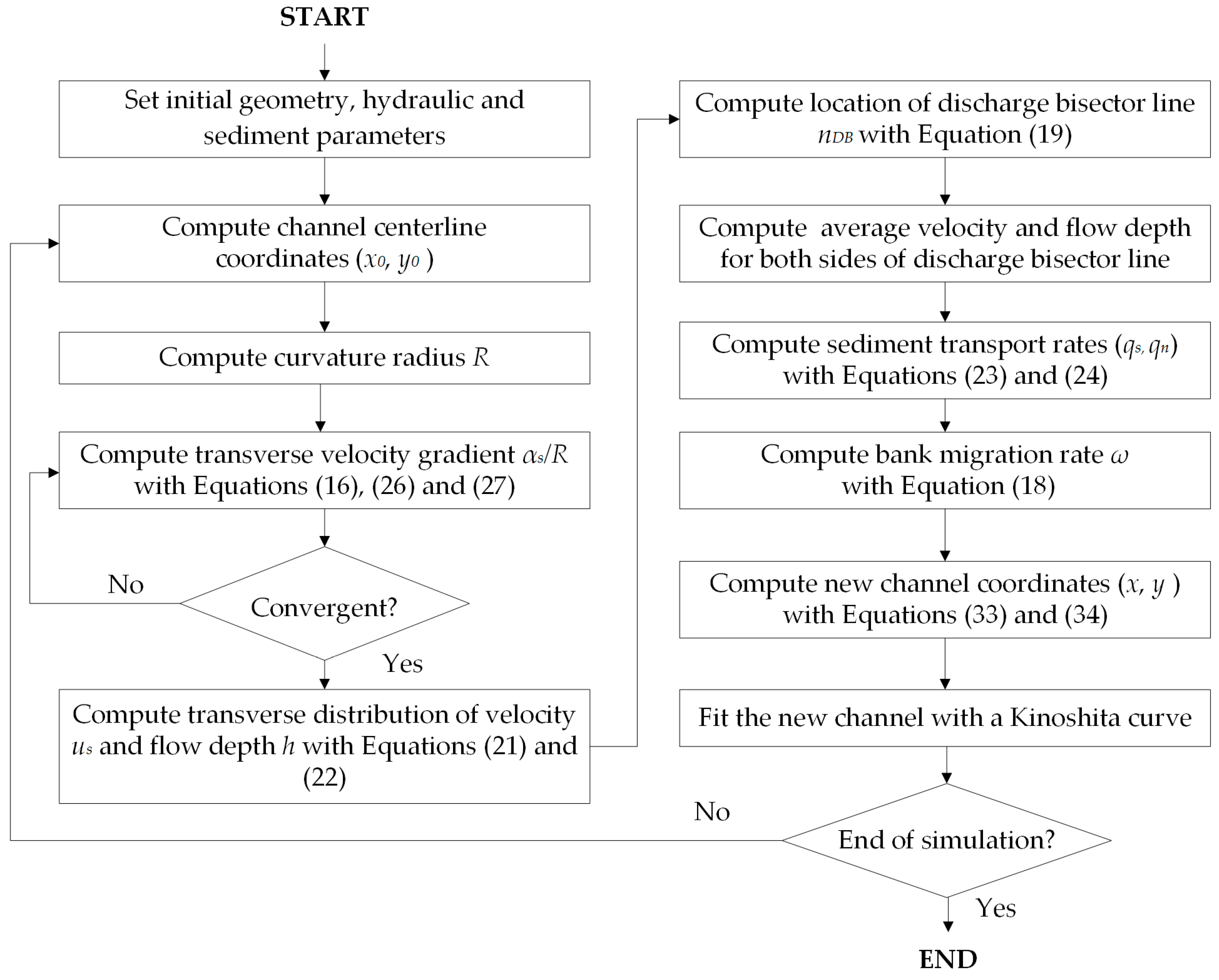


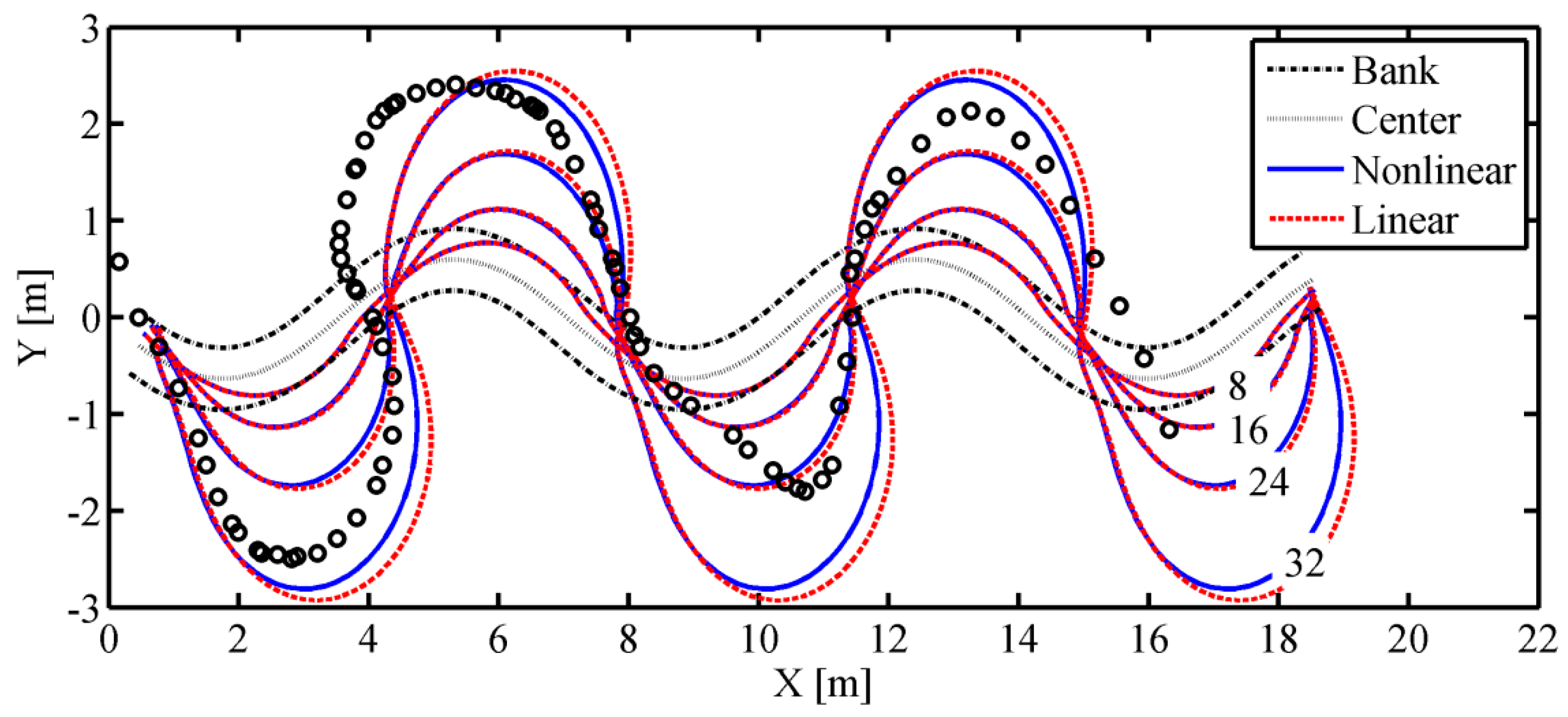
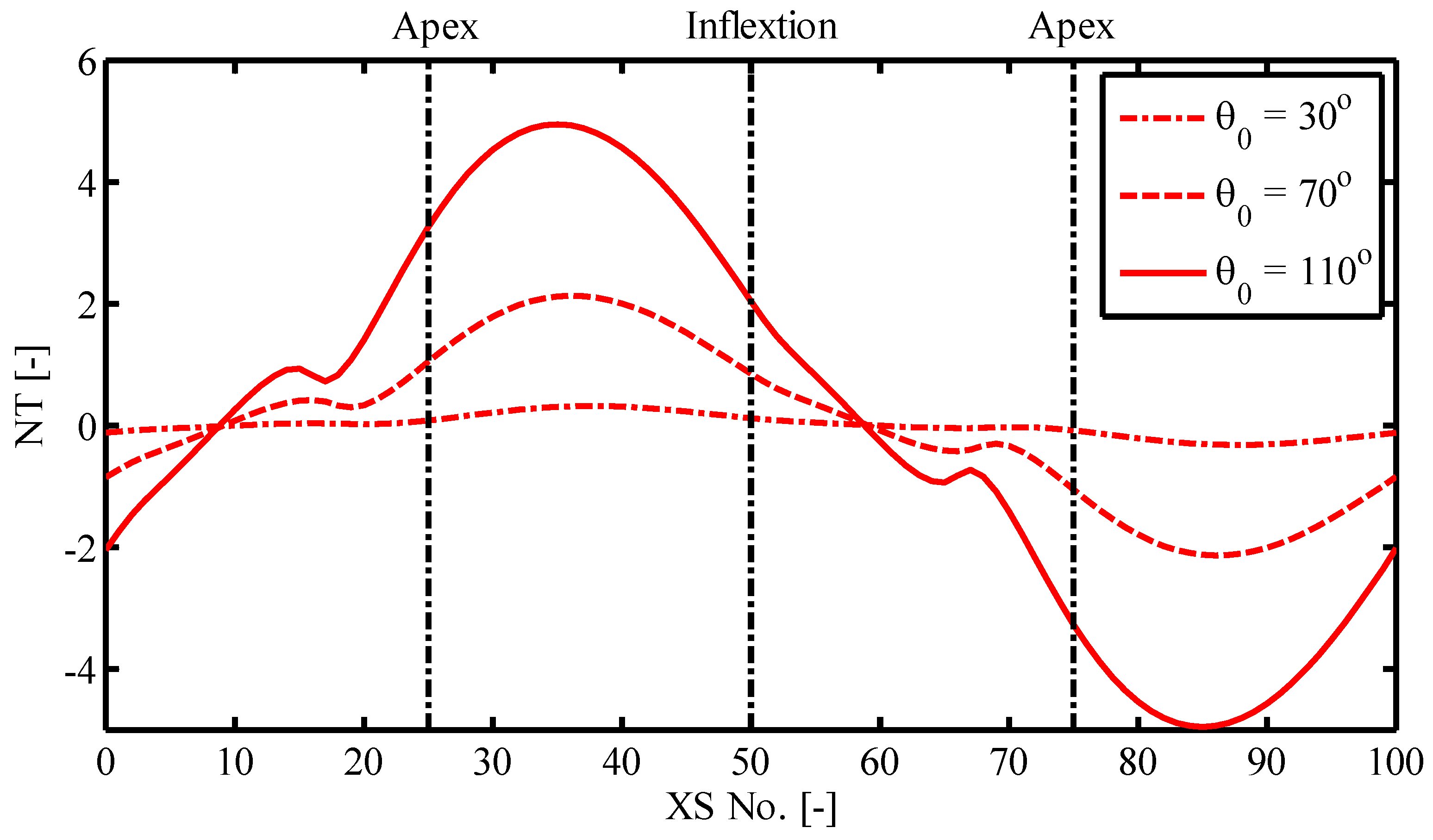
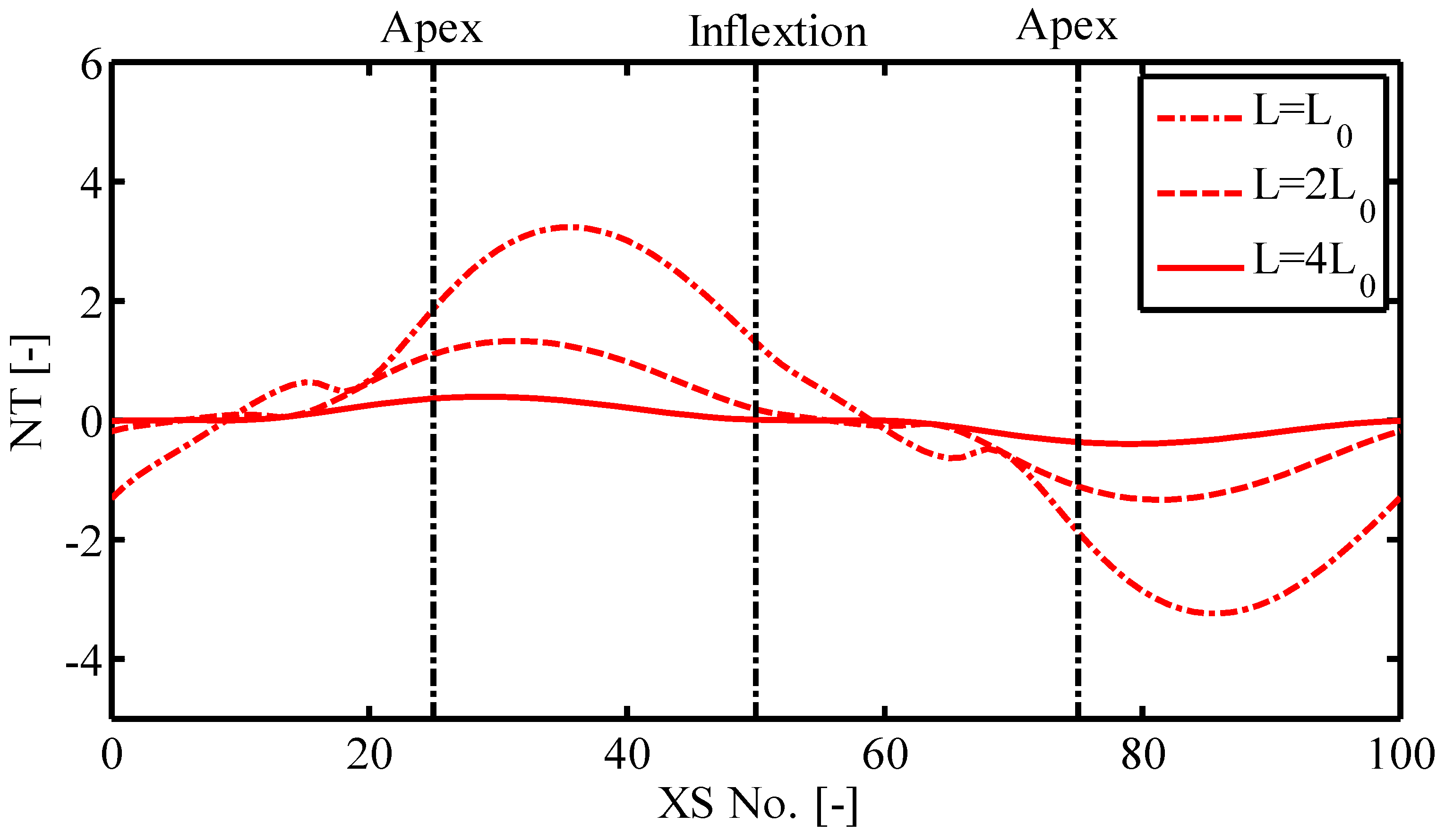
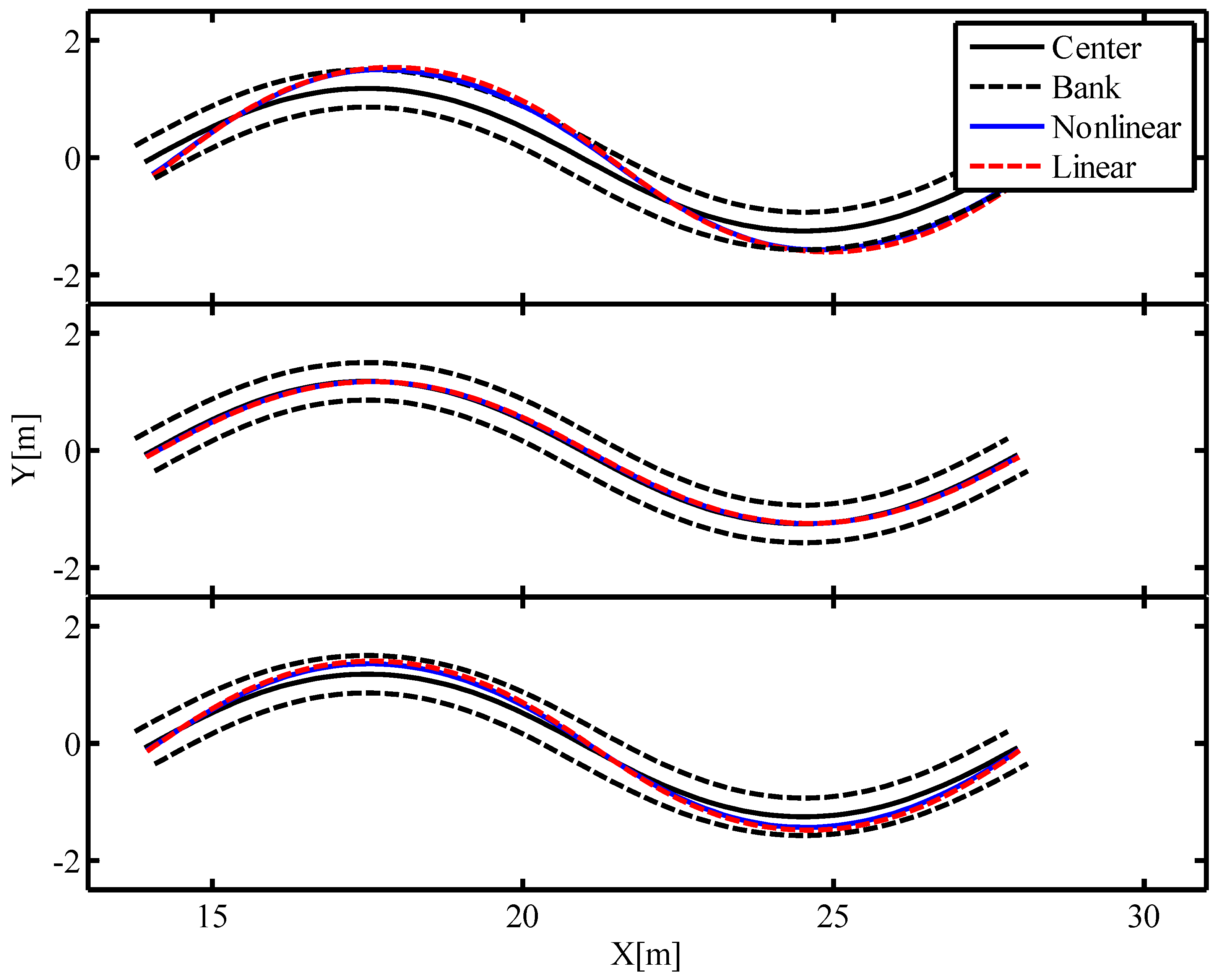

| Parameter | SA1 | SA2 | ||||
|---|---|---|---|---|---|---|
| Scenario 1 | Scenario 2 | Scenario 3 | Scenario 1 | Scenario 2 | Scenario 3 | |
| Q (m3/s) | 0.02 | 0.02 | 0.02 | 0.02 | 0.02 | 0.02 |
| H (m) | 0.1 | 0.1 | 0.1 | 0.1 | 0.1 | 0.1 |
| B (m) | 0.64 | 0.64 | 0.64 | 0.64 | 0.64 | 0.64 |
| S (-) | 0.0075 | 0.0075 | 0.0075 | 0.0075 | 0.0075 | 0.0075 |
| d50 (mm) | 0.45 | 0.45 | 0.45 | 0.45 | 0.45 | 0.45 |
| θ0 (°) | 30 | 70 | 110 | 90 | 90 | 90 |
| L/B (-) | 23.5 | 23.5 | 23.5 | 23.5 | 47.1 | 94.1 |
© 2016 by the authors; licensee MDPI, Basel, Switzerland. This article is an open access article distributed under the terms and conditions of the Creative Commons Attribution (CC-BY) license (http://creativecommons.org/licenses/by/4.0/).
Share and Cite
Gu, L.; Zhang, S.; He, L.; Chen, D.; Blanckaert, K.; Ottevanger, W.; Zhang, Y. Modeling Flow Pattern and Evolution of Meandering Channels with a Nonlinear Model. Water 2016, 8, 418. https://doi.org/10.3390/w8100418
Gu L, Zhang S, He L, Chen D, Blanckaert K, Ottevanger W, Zhang Y. Modeling Flow Pattern and Evolution of Meandering Channels with a Nonlinear Model. Water. 2016; 8(10):418. https://doi.org/10.3390/w8100418
Chicago/Turabian StyleGu, Leilei, Shiyan Zhang, Li He, Dong Chen, Koen Blanckaert, Willem Ottevanger, and Yun Zhang. 2016. "Modeling Flow Pattern and Evolution of Meandering Channels with a Nonlinear Model" Water 8, no. 10: 418. https://doi.org/10.3390/w8100418






